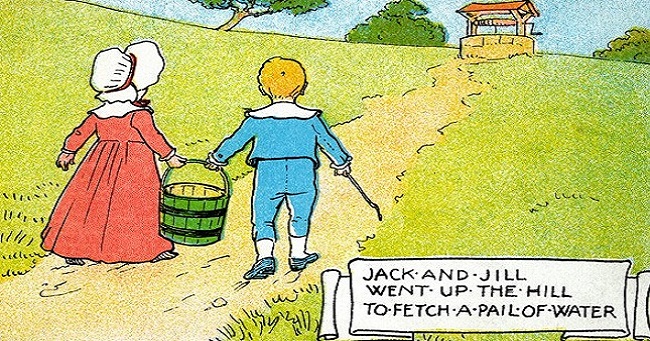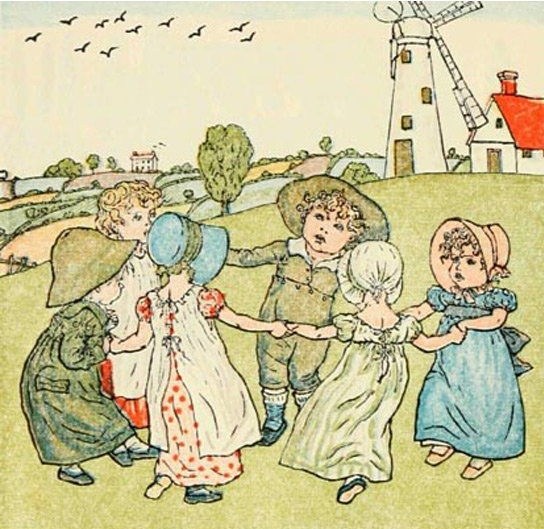


Did you sing Ring-a-round the roses when you were a kid? Did you know that it had a very sinister and hidden meaning? Yes!! Among many old and traditional nursery rhymes, there lurks a dark secret that not many know about. It so happens that several events in history served as the inspiration for nursery rhymes under the banner “Mother Goose’s Nursery Rhymes” as we know them today. Read on to find out the secret origins behind nursery rhymes still sung today.
“Ring a Ring o Roses, or Ring around the Rosie” dates back to 1881. Although a very controversial nursery rhyme, it was considered as a reference to the great plague of London in 1665. While some feel it isn’t possible and there are different theories, this explanation matches the lines of the poem which is rather self explanatory.. Ring of roses refers to the malodorous rash that would appear on the skin as a result of the bubonic plague infection. “Pocket full of posies” refers to the bunch of Posies people carried in their pockets believing it would protect them from disease and the last line “atishoo atishoo we all fall down”. Well!! If that doesn’t explain it what does?

Image Source: www.pinimg.com
Baa Baa Black sheep was about the taxes imposed on farmers by King Edward the 1st in 1275. The new tax levied one third of a sack of wool to the king and one third to the church and the last to the farmer referred to as the little boy who lives down the lane. Hence Baa Baa Black sheep was a very negative theme. In the 20Th century, the word “black” and “master” was regarded as racial by various bodies and the poem was even banned by some schools. Others innovated by changing the word “black’ for less offensive words. Some like even suggested as “Baa Baa Rainbow sheep” as an alternative.
Image Source: www.ytimg.com
Humpty Dumpty wasn’t just the four line rhyme as you know it. First here is the real version In sixteen hundred and forty-eight? When England suffered pains of state? The Roundheads laid siege to Colchester town? Where the King’s men still fought for the crown.?? There one-eyed Thompson stood on the wall? A gunner with the deadliest aim of all? From St Mary’s tower the cannon he fired? Humpty Dumpty was his name.?? Humpty Dumpty sat on the wall? Humpty Dumpty had a great fall? All the King’s horses and all the King’s men? Couldn’t put Humpty Dumpty together again!??
Humpty Dumpty was a CANNON!! The weapon was owned by the supporters of King Charles I to gain control over the city of Colchester during the English Civil war. Once they secured Colchester, the cannon was placed upon a church tower in until it was destroyed by a barrage of enemy cannon balls. The cannon fell into the marshland below and as the rhyme says, “All the kings’ horses and all the kings’ men couldn’t put humpty together again”.
Image Source: www.goread.com
Among the secret origins behind nursery rhymes, Goosey Goosey Gander hid the sinister theme of religious persecution at a time when catholic priests in England were forbidden to say their Latin based prayers in public or even in the secrecy of their homes. The original version narrates “There I met an old man, who wouldn’t say his prayers; I caught him by the left leg and threw him down the stairs”
The weirdest fact of such poems is that despite of harboring acts of violence, they are still considered innocent rhymes taught to children. How many of us remember being taught such rhymes at school not really knowing what we were saying.
Image Source: www.smallkidshomework.com
Mary was referred to as Mary I daughter of Henry VIII and sister to Elizabeth. At that time Henry was married to Catherine of Aragon and they had one child, Mary. If you know your history, it was Henry VIII who rebelled against the Catholic Church in order to divorce and marry Anne Boleyn. When Henry Died, Mary ascended the throne and tried to make England Catholic again, so in effect she went “quite contrary” to England’s wishes. She was being referred to as a gardener in the rhyme. Silver bells, cockle shells are all symbolic of torture devices used at the time.
Image Source: www.mamalisa.com
Rock a bye baby, is with reference to the events of the Glorious Revolution where the baby is symbolic of the son of King James II of England. The prince was believed to be the child of someone else smuggled into the birthing room to ensure a Roman Catholic heir. The wind in the rhyme refers to the protestant forces blowing in from the Netherlands and the doomed cradle was the royal House of Stuart. The earliest record of this rhyme in print also came with a footnote saying: “This may serve as a warning to the Proud and Ambitious, who climb so high that they generally fall at last”.
Image Source: www.mamalisa.com
Three Blind Mice written in 1805 was another reference to Bloody Mary’s reign. The three blind mice was believed to be the three Protestant bishops, Hugh latimer, Nicholas Radley and The Archbishop of Canterbury, Thomas Crammer who had conspired to overthrow Mary but were Unsuccessful. Mary had them burnt at the stake.
Image Source: www.scribblelive.com
Old Mother Hubbard wasn’t a mother at all. The poem is believed to represent a mockery of Cardinal Thomas Wolsey who refused to give Henry VIII an annulment of his marriage so he could marry Anne Boleyn. The act led to the Cardinal’s downfall.
ww.museumofplay.org
The poem was written in 1840. According to historian R.S.Duncan who was also the former governor of England’s Wakefield Prison, the rhyme originated from the 420 year old institution’s practice of exercising female prisoners around a mulberry tree.
Image Source: www.siyalla.com
Ladybird Ladybird fly away home? your house is on fire and your children are gone,? All except one called Anne? For she has crept under the frying pan.??
The secret origins behind nursery rhymes included even the humble ladybird poem. The lady bird in this case wasn’t a ladybird but a catholic in 16th century Protestant England. Catholics at the time were forbidden to practice their religion both in public and at home. They were also forced to attend Protestant services failing which they were made to pay hefty fines. The fire could be a reference to the catholic priests who were burned at the stake for their beliefs.
Image Source: www.wordpress.com